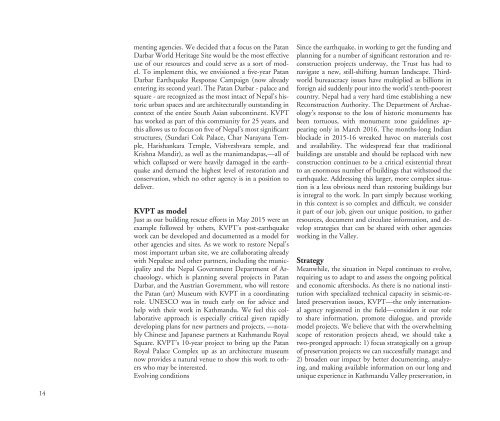KVPT’s Patan Darbar Earthquake Response Campaign - Work to Date - September 2016
You also want an ePaper? Increase the reach of your titles
YUMPU automatically turns print PDFs into web optimized ePapers that Google loves.
menting agencies. We decided that a focus on the <strong>Patan</strong><br />
<strong>Darbar</strong> World Heritage Site would be the most effective<br />
use of our resources and could serve as a sort of model.<br />
To implement this, we envisioned a five-year <strong>Patan</strong><br />
<strong>Darbar</strong> <strong>Earthquake</strong> <strong>Response</strong> <strong>Campaign</strong> (now already<br />
entering its second year). The <strong>Patan</strong> <strong>Darbar</strong> - palace and<br />
square - are recognized as the most intact of Nepal’s his<strong>to</strong>ric<br />
urban spaces and are architecturally outstanding in<br />
context of the entire South Asian subcontinent. KVPT<br />
has worked as part of this community for 25 years, and<br />
this allows us <strong>to</strong> focus on five of Nepal’s most significant<br />
structures, (Sundari Cok Palace, Char Narayana Temple,<br />
Harishankara Temple, Vishveshvara temple, and<br />
Krishna Mandir), as well as the manimandapas,—all of<br />
which collapsed or were heavily damaged in the earthquake<br />
and demand the highest level of res<strong>to</strong>ration and<br />
conservation, which no other agency is in a position <strong>to</strong><br />
deliver.<br />
KVPT as model<br />
Just as our building rescue efforts in May 2015 were an<br />
example followed by others, <strong>KVPT’s</strong> post-earthquake<br />
work can be developed and documented as a model for<br />
other agencies and sites. As we work <strong>to</strong> res<strong>to</strong>re Nepal’s<br />
most important urban site, we are collaborating already<br />
with Nepalese and other partners, including the municipality<br />
and the Nepal Government Department of Archaeology,<br />
which is planning several projects in <strong>Patan</strong><br />
<strong>Darbar</strong>, and the Austrian Government, who will res<strong>to</strong>re<br />
the <strong>Patan</strong> (art) Museum with KVPT in a coordinating<br />
role. UNESCO was in <strong>to</strong>uch early on for advice and<br />
help with their work in Kathmandu. We feel this collaborative<br />
approach is especially critical given rapidly<br />
developing plans for new partners and projects, —notably<br />
Chinese and Japanese partners at Kathmandu Royal<br />
Square. <strong>KVPT’s</strong> 10-year project <strong>to</strong> bring up the <strong>Patan</strong><br />
Royal Palace Complex up as an architecture museum<br />
now provides a natural venue <strong>to</strong> show this work <strong>to</strong> others<br />
who may be interested.<br />
Evolving conditions<br />
Since the earthquake, in working <strong>to</strong> get the funding and<br />
planning for a number of significant res<strong>to</strong>ration and reconstruction<br />
projects underway, the Trust has had <strong>to</strong><br />
navigate a new, still-shifting human landscape. Thirdworld<br />
bureaucracy issues have multiplied as billions in<br />
foreign aid suddenly pour in<strong>to</strong> the world’s tenth-poorest<br />
country. Nepal had a very hard time establishing a new<br />
Reconstruction Authority. The Department of Archaeology’s<br />
response <strong>to</strong> the loss of his<strong>to</strong>ric monuments has<br />
been <strong>to</strong>rtuous, with monument zone guidelines appearing<br />
only in March <strong>2016</strong>. The months-long Indian<br />
blockade in 2015-16 wreaked havoc on materials cost<br />
and availability. The widespread fear that traditional<br />
buildings are unstable and should be replaced with new<br />
construction continues <strong>to</strong> be a critical existential threat<br />
<strong>to</strong> an enormous number of buildings that withs<strong>to</strong>od the<br />
earthquake. Addressing this larger, more complex situation<br />
is a less obvious need than res<strong>to</strong>ring buildings but<br />
is integral <strong>to</strong> the work. In part simply because working<br />
in this context is so complex and difficult, we consider<br />
it part of our job, given our unique position, <strong>to</strong> gather<br />
resources, document and circulate information, and develop<br />
strategies that can be shared with other agencies<br />
working in the Valley.<br />
Strategy<br />
Meanwhile, the situation in Nepal continues <strong>to</strong> evolve,<br />
requiring us <strong>to</strong> adapt <strong>to</strong> and assess the ongoing political<br />
and economic aftershocks. As there is no national institution<br />
with specialized technical capacity in seismic-related<br />
preservation issues, KVPT—the only international<br />
agency registered in the field—considers it our role<br />
<strong>to</strong> share information, promote dialogue, and provide<br />
model projects. We believe that with the overwhelming<br />
scope of res<strong>to</strong>ration projects ahead, we should take a<br />
two-pronged approach: 1) focus strategically on a group<br />
of preservation projects we can successfully manage; and<br />
2) broaden our impact by better documenting, analyzing,<br />
and making available information on our long and<br />
unique experience in Kathmandu Valley preservation, in<br />
14




